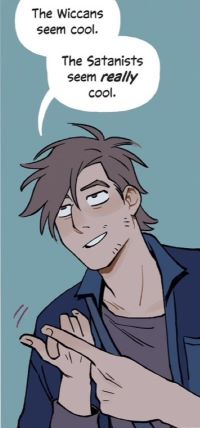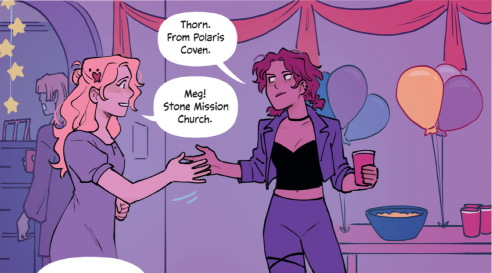Last Tuesday marked the release of Youth Group, a comedic horror graphic novel by Jordan Morris and Bowen McCurdy. I had learned about it from listening to the interview Morris gave on the Thereafter podcast and pre-ordered it. As son as the book hit my Kindle account, I downloaded it and tore through it, even tweeting a bit about it as I read along.
The graphic novel is incredible and there are so many things I could say about it. But for this post, I want to focus on one particular aspect of the story: The way that the author (and illustrator) tackled the topic of interfaith cooperation.
Before I dig in too deep, I want to start by noting that this blog post will contain images of individual panels from the graphic novel. Rather than relying on a “Fair Use” defense, I decided to contact Jordan Morris directly and ask for permission to do so. He responded and gave me permission, asking that I only avoid including spoilers.1 I have done my best to honor that request, and I don’t think anything I’ve included gives away any major plot points. Special thanks to Jordan for giving me permission, though.
About a third of the way into the graphic novel, I was a bit concerned about how they might be treating non-Christian religions in it. After all, one demon seemed to be posing as a “crystal healing therapist” and in another case, a character scratching out runes was seen as a sign of demonic possession. I tweeted out a carefully nuanced tweet about my concerns regarding this, acknowledging that this might be unintentional. I explained where my concern really lie and how that was important without detracting from or erasing the positive qualities of the book.
Of course, my fears were greatly alleviated a few pages later, when I ran across one of the evangelical Christian demon hunters saying the following:
With that one thread, Morris and McCurdy let me know that in this world of theirs, there were Wiccans and Satanists who also hunted demons. I was immediately relieved that this was not a “Christians vs. the ‘weird occult religions'” scenario after all. And yet, what came later was even more of a surprise. Morris and McCurdy didn’t just tell us that that non-Christian demon hunters existed, but introduced us to a few of them.2
The protagonists — a trio of demon hunters from an evangelical church — talk about the existence of other religious groups having demon hunters and consider getting together with them to at least compare notes with one another. As they consider this, they find themselves obligated to deal with the prejudices many evangelical and other conservative/authoritarian Christians have against people from other religions. But eventually, our protagonists decide to have a party where they invite the other demon hunters,3 and they all get together. Some stereotypes are addressed and knowledge is shared, modeling beautifully what interfaith dialogue and cooperation should look like.
This meeting of the minds becomes important to the plot. After the party, the classic “looks like the bad guys might win after all” event takes place and our demon hunters find themselves having to re-evaluate things and figure out what to do. During that time, the protagonist Cortland ends up meeting with the Wiccan demon hunters and they work together to uncover a secret that, in my opinion at least, seems central to the story and its resolution. (I won’t go into details because that would totally be a spoiler.)
The important thing to note though is that they learn this secret through a technique only the Wiccans seem to know about. Of course, the Wiccans also need Cortland because of experiences he has that make him uniquely qualified to help them out in this endeavor. So it is only through the cooperation of people from two different religious traditions that this pivotal (in my opinion at least) plot point can unfold.
This, my friends, is the kind of interfaith cooperation we need to see more of, both in popular culture and in the real world. This acknowledgement that none of these groups can hope to succeed in this fight alone is so vital and one that I hope people take to heart reading this graphic novel.
I, like Meghan Crozier, am rooting for there to be a sequel. And I hope that the sequel continues to portray the kind of interfaith cooperation that this first book did. Of course, as Morris and McCurdy continue to represent other faiths, I hope and trust they will consult members of those faiths.4 To that end, I’d like to offer myself as a non-Wiccan witch with a fair amount of knowledge about Wicca as someone they can run ideas by and/or ask for advice. If you don’t already have that connection through some other source.
Footnotes
- Okay, he also asked me to tag him in the post. But that was a foregone conclusion whether he requested it or not. ↩︎
- Sadly, we don’t get to meet any demon hunters that are Satanists (maybe that’ll come up in the sequel some of us are hoping for?) Which is a shame. Of course, I could see that leading to some interesting story-telling and world-building. Here in the real world, the two best known Satanic organizations don’t actually believe in supernatural beings. So did the Satanic demon hunters in this fictional universe start as theistic Satanists? Or are they members of the CoS/TST who are dealing with the realization that their disbelief in the supernatural was unfounded? ↩︎
- Wiccan, Jewish, and Catholic demon hunters show up, though the Jewish and Catholic demon hunters are mostly silent/unseen during this part of the story beyond announcing their appearance. I will note a couple of the evangelical Christian demon hunters do receive training through a Catholic group later in the story, however. ↩︎
- On that note, a minor nitpick/note for the authors: You two know that most Wiccans don’t actually draw pentagrams on the floor for their rituals, right? I’m hoping you did that because it’s an easy identifier despite being pretty trope-ish. ↩︎


